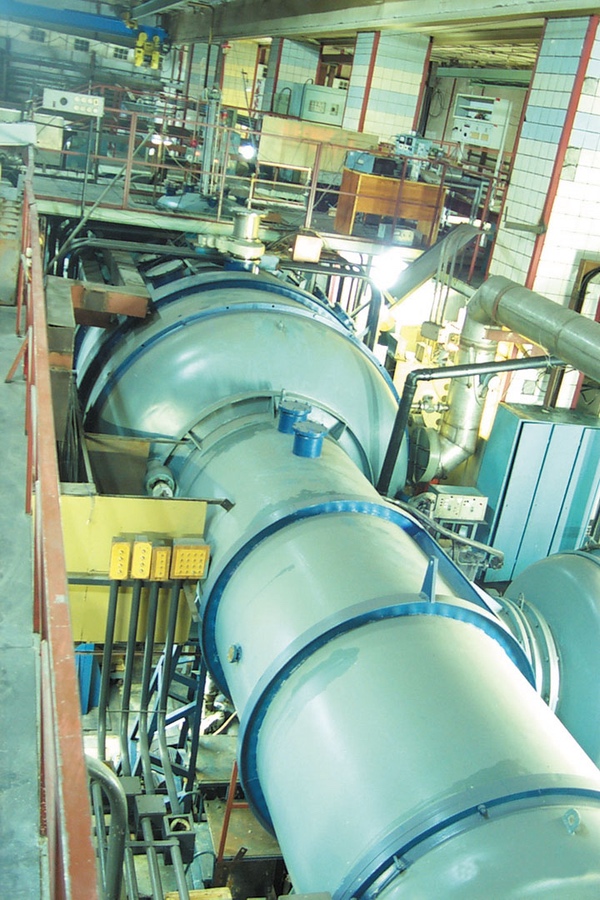Russian research on space nukes and alternative counterspace weapons (part 2)by Bart Hendrickx
|
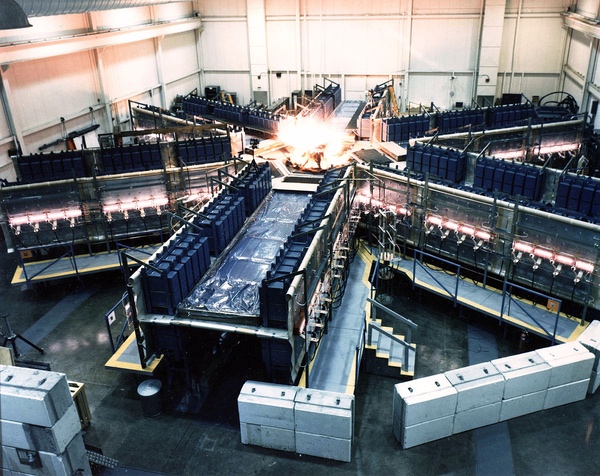 The Shiva capacitator bank used for the MARAUDER experiments. |
Stupitskiy first wrote about plasma guns early this century, but the research seems to have shifted into higher gear in recent years. Evidently, ways have been found to reduce the size of plasma guns enough to consider mounting them on orbiting platforms. How exactly this would be done is not explained. The Russian researchers have studied the formation of the plasma toroid shortly after it leaves the generator, its subsequent propagation through the ionosphere, and its effects on satellites. Papers published in 2019 and 2020 leave little doubt that the main goal of the research is to study the possibility of turning plasma guns into anti-satellite weapons. They describe how the plasma waves could significantly decrease the transparency of glass layers used in satellite optical systems and affect the operation of space-based radio communication and radar systems “operating in the megahertz range.”
| Stupitskiy first wrote about plasma guns early this century, but the research seems to have shifted into higher gear in recent years. Evidently, ways have been found to reduce the size of plasma guns enough to consider mounting them on orbiting platforms. |
The investigations have shown that as the plasma cloud expands, it becomes less dense and many of the positive ions capture free electrons to form neutral hydrogen atoms. These are not influenced by the Earth’s geomagnetic field and can therefore travel significant distances to potential target satellites. Stupitskiy’s team estimates that if the plasma cloud is generated between altitudes of 150 and 300 kilometers, its range could be anywhere from 8 to 100 kilometers. Also, the wider the cloud becomes, the more chance it has of encountering target satellites. All this suggests that such a weapon would be designed to attack multiple satellites.
The work has seemingly expanded beyond mere computer simulations. A 2019 paper on the subject was co-authored by specialists of the Troitsk Institute of Innovative and Thermonuclear Research (TRINITI). Subordinate to the Rosatom State Corporation, TRINITI is a leading Russian research center in the field of controlled thermonuclear fusion, plasma physics, and laser physics. It has various testbeds that simulate the effects of high-speed plasma waves on various materials. The experiments are primarily geared to building future nuclear fusion reactors but can apparently also be applied to plasma guns. Anti-satellite plasma guns were one of the subjects of a recent PhD dissertation supervised by Stupitskiy. In a YouTube video of the PhD defense, Stupitskiy can be heard saying that TRINITI is building a plasma installation “considerably bigger” than the one at the US Air Force’s Phillips Lab (now called the Air Force Research Laboratory.) However, it is not entirely clear if he was talking about an installation capable of hosting experiments similar to MARAUDER.
Another co-author of the 2019 paper works for Roscosmos’ Scientific Test Center of the Rocket and Space Industry (NITs RKP) near Sergiyev Posad. NITs RKP operates a wide range of test stands for rocket engines and also has a number of thermal vacuum chambers to simulate space conditions. While the exact role of NITs RPK in the research is unclear, its involvement does indicate that the development of space-based plasma weapons is of more than purely academic interest.[1]
Stupitskiy’s team has also done research into the release of chemical substances into the ionosphere. Experiments of that type were performed last century with both satellites and sounding rockets. One that forms the basis for the new research is a joint American-Russian experiment called “North Star”, carried out with the help of a Black Brant XII sounding rocket launched from the Poker Flats Research Range in Alaska on January 22, 1999. The rocket carried explosive-type generators which produced two high-speed aluminum ion plasma jets to study their interaction with the space environment. Although the mission had purely scientific goals, the IAP researchers are using the obtained data for other purposes. They have focused on the fact that some of the molecules formed by these events, such as carbon dioxide, carbon monoxide and water, are capable of emitting in the infrared range of the spectrum. In their literature on the research, they do not specify why this is of interest to them, but in the earlier mentioned PhD thesis defense, Stupitskiy said that the release of chemicals in space could create what he called an “interference environment” in the infrared range of the spectrum.[2]
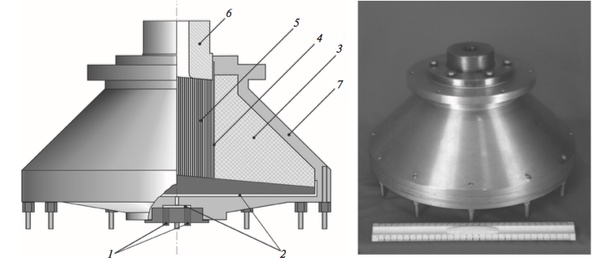 Explosive-type generator flown during the “North Star” mission in 1999. (Source) |
It is clear, though, that such experiments can have other military applications as well. As noted by Stupitskiy in some of his publications, the release of chemicals such as barium into the ionosphere can also mimic some of the effects of high-altitude nuclear explosions. Most likely, such experiments would also be applicable to space-based plasma weapons.
Laboratory simulations of satellite-based chemical release experiments have been carried out since at least 2018 by a team at the Institute of Applied Physics (IPF) in Nizhniy Novgorod. IPF has a large vacuum chamber called Krot (“mole”) with a diameter of three meters and a length of ten meters, which is used to simulate a wide variety of processes in space. For this particular series of experiments, the chamber is outfitted with a so-called co-axial plasma gun to study the behavior of an expanding plasma cloud in a magnetic field. As literally stated in one of the articles, their purpose is to create “dense plasma clouds to simulate the explosive injection of ionized matter into the ionosphere by satellites.” Another paper talks about “the generation of nearly spherical expanding clouds to simulate natural and artificial explosions in space.” In one of the IPF papers, reference is made to the work on plasma guns done by Stupitskiy’s team at IAP, although there is no evidence for any direct collaboration between IPF and IAP.[3]
Similar work has been done by a team of the Institute of Laser Physics (ILF) in Novosibirsk. Using a laser facility called KI-1, spherical plasma clouds are created by exposing one-centimeter plastic targets to the beams of four carbon-dioxide lasers mounted around them in a tetrahedral pattern. The stated goal is to “model the 3D-dynamics of artificial plasma releases in near-Earth space”. The spherical plasma clouds are compared to those formed during barium release experiments performed by AMPTE, a German satellite launched in 1984.[4] Some of the IPF and ILF papers on this topic are co-authored by specialists of RFYaTs-VNIIEF. There has been at least some co-operation between IPF and ILF in experiments using the Krot plasma chamber, although these are linked solely to astrophysical research.[5]
| Russia is not known to have any active sounding rocket programs, meaning that any such experiments would most likely have to be staged from satellites. |
As noted in some of the papers by the IPF team, the advantage of the laboratory experiments over actual experiments in space is that they can be repeated multiple times and re-create a wide variety of conditions in the ionosphere. However, a recent article in a Russian military journal pointed out some of the drawbacks of laboratory experiments, including the limited size of the vacuum chambers and the negative influence of the walls of such chambers. It said that only in-situ experiments can provide a full understanding of disturbances in the ionosphere caused by plasma formations of “natural and technogenic origin” and their effects on satellites and their communications systems. The article mentions new technological breakthroughs in the design of explosive-type plasma generators, which could use “any solid material” as an explosive substance. Having “no analogues abroad”, such generators could be delivered to any altitude depending on the “carrier” used and several of them could be assembled together to create “significantly more energy.”[6]
Russia has not announced any plans for new space-based chemical release experiments for scientific purposes, raising the question if the work is paving the way for missions to simulate nuclear explosions in space and/or test the potential use of space-based plasma weapons. Russia is not known to have any active sounding rocket programs, meaning that any such experiments would most likely have to be staged from satellites. There is no evidence that any such missions are being actively prepared, but building the hardware for them should not pose any insurmountable technical challenges.
Radio frequency weapons
One of the most damaging effects of a high-altitude nuclear blast is the electromagnetic pulse (EMP), a short-duration pulse of energy that can not only seriously damage ground-based electronic systems, but also wreak havoc on unprotected satellites in Earth orbit. Electromagnetic pulses are also created by natural events such as lightning and solar coronal mass ejections.
Studies of nuclear EMPs in the 1960s inspired researchers to investigate the possibility of generating similar types of electromagnetic radiation that would have some of the same effects without requiring a nuclear detonation. They would use shorter waveforms at higher frequencies, making them highly effective against electronic equipment and more difficult to harden against. Such directed-energy weapons are referred to with various terms, including non-nuclear electromagnetic weapons, microwave weapons, and radio frequency weapons. Unlike traditional electronic warfare systems, which are designed to temporarily jam enemy transmitters, they are intended to cause permanent damage to electronic systems by overwhelming them with high intensity radiation, either in the form of a single short pulse or bursts of short pulses. This can be achieved by penetrating targets via their antennas (a method known as “front-door coupling”) or through openings in their shielding (“back-door coupling”). Such openings can be cracks, seams, seals, conduits, electrical wiring, apertures, solar cells, optical sensors, and so on.
Radio frequency weapons are generally classified in two main groups: narrowband or high-power microwave (HPM) devices and ultra-wide band (UWB) or beamless devices (although HPM is also sometimes used as a general term for these weapons.) HPM weapons generate radio frequency beams at very narrow frequency bands and have high directivity. UWB weapons cover a wide frequency spectrum and have limited directivity. HPM weapons are most suited to front-door coupling because all their energy can be focused into the narrow frequency range of the antenna. UWB weapons, while less powerful, are more effective at back-door coupling because of the wide range of frequencies involved, which allows them to penetrate the target from multiple points.
HPM devices consist of a high-power pulse generator, a high-power microwave generator capable of converting the high-power pulse into narrowband radio frequency signals, and an antenna. UWB devices do not require a microwave generator because the conversion of the pulsed power to a UWB signal happens at the antenna. Protective measures against nuclear EMPs are not as effective against HPM and UWB weapons because of the higher frequencies and shorter pulse times.[7]
One of the drawbacks of radio frequency weapons often cited in literature on counterspace systems is their relatively limited range. Since microwaves have wavelengths thousands of times longer than optical light, it is more difficult to focus the radiation over long distances. Ground-based anti-satellite microwave weapons would require high levels of emitted power and large antennas for focusing the beam and would also have to contend with interference from the atmosphere and lower ionosphere. Therefore, space-based radio frequency weapons capable of approaching their targets up close (either in co-planar or crossing orbits) have generally been considered more effective.[8]
| Some of the Russian academic literature suggests that there is a particular interest in anti-satellite radio frequency weapons generating ultra-wide band signals. |
Russian interest in space-based radio frequency weapons is evident from an essay on counterspace systems published in the leading military journal Voyennaya mysl last year. It says that space-based electronic warfare systems can evolve into radio frequency weapons in case the on-board power supply is increased. Elsewhere in the article, the authors note that counterspace weapons (and especially directed-energy weapons) with high power levels will make it possible to increase their range, which in turn places less stringent demands on their maneuverability.[9] Ekipazh, the nuclear-powered satellite under development at KB Arsenal, should meet those requirements, but it is impossible to say if it is a jammer or a radio frequency weapon.
Some of the Russian academic literature suggests that there is a particular interest in anti-satellite radio frequency weapons generating ultra-wide band signals. Pointing to that is the fact that a considerable amount of research in recent years has focused on the propagation of UWB electromagnetic pulses through the ionosphere. Theoretical papers on this topic have been published by RFYaTs-VNIIEF and the Ministry of Defense’s 12 TsNII research institute. One aspect of the work at 12 TsNII has been to analyze how the ionosphere can affect the ability of UWB signals to penetrate openings in the shielding of satellites; in other words, how effective the back-door coupling effects would be in the space environment. For some reason, the institute has also studied how a high-altitude nuclear blast could affect UWB signals traveling through the ionosphere.[10]
This research, too, has moved to the laboratory. IPF’s Krot plasma chamber in Nizhniy Novgorod has been configured for studies of UWB signal propagation through the ionosphere by outfitting it with what the Russians call a “gigantic coaxial line,” a ten-meter-long device filled with plasma that is connected to generators of nanosecond and sub-nanosecond EMPs. Some of the articles on the experiments are co-authored by specialists of RFYaTs-VNIIEF. The actual goals of the experiments are kept vague. Among the areas of application are UWB radio communication systems using ionospheric channels, space-based systems to monitor “natural and technogenic events,” and “analysis of the influence of lightning-generated EMPs and explosion-type phenomena on space equipment.”[11]
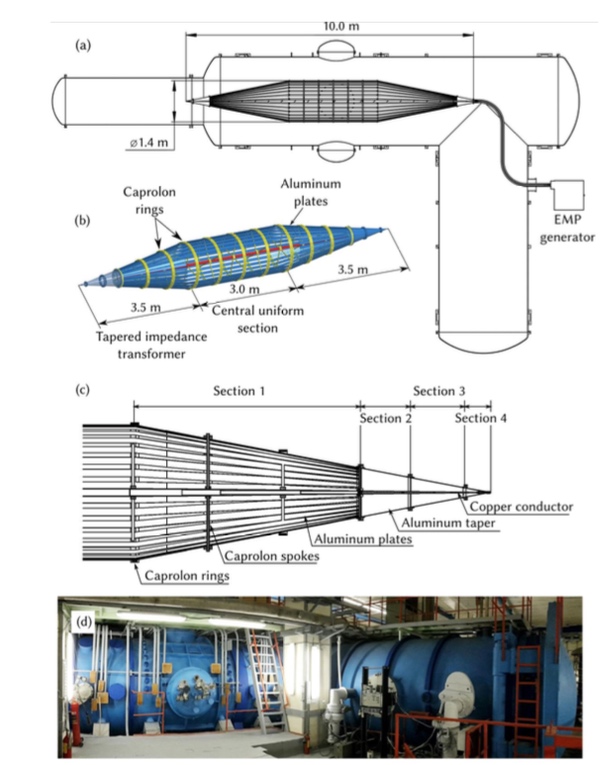 The Krot plasma chamber outfitted with a “gigantic coaxial line”, shown in detail in drawings (b) and (c). (Source) |
Other experimental work in this area (referenced in some of the papers on the Krot UWB experiments) is being done by a team of the Russian Academy of Sciences’ Joint Institute for High Temperatures (OIVT) in collaboration with the Prokhorov Institute of General Physics (IOF) and RFYaTs-VNIIEF. This involves studying the propagation of UWB signals through the atmosphere with the help of equipment installed both on the ground and aboard balloons. The ultimate goal is to place the UWB transmitter and the receiver ten kilometers from each other and extrapolate some of the results of the measurements to UWB signal propagation in the ionosphere. As noted by the researchers, such measurements could also be made by mounting an UWB transmitter on a sounding rocket, but they give no clues that such an option is being actively considered.[12]
Despite the earlier noted disadvantages of deploying anti-satellite radio frequency weapons on the ground, there are some signs that this is exactly where the Russians want to place the UWB weapons. In their studies of the back-door coupling effects of UWB signals on satellites, specialists of the 12 TsNII research institute used algorithms that assumed the signals would follow “a vertical Earth-ionosphere trajectory.”
Another clue comes from a paper by one of the RFYaTs-VNIIEF researchers involved in the Krot UWB experiments. It was presented jointly with specialists of KB Arsenal at a military conference in 2022 and titled “Theoretical and experimental foundations for constructing a complex using powerful generators of ultra-wide band electromagnetic pulses to electronically disable on-board equipment of air-based and space-based assets”. The abstracts of the paper are not available, making it impossible to determine exactly what is being proposed. However, it was presented in the section devoted to Navy projects, suggesting it may have been about a sea-based radio frequency weapon powerful enough to target both aircraft and satellites. KB Arsenal does have the necessary connections with the Navy, building both ship-mounted artillery systems and the country’s ocean reconnaissance satellites.[13]
| Studying UWB signal propagation through the ionosphere also seems to be one of the objectives of a top-secret military space project called Numizmat (“coin collector”). |
So is there any evidence that a ground-based UWB weapon is under development? The least that can be said is that significant progress has been made in recent years on relatively compact, yet powerful, electromagnetic pulse generators that can inflict damage on targets located at considerable distances. Last year, for instance, Chinese scientists were reported to have developed a small ten-gigawatt ground-based microwave device that could emit ten pulses per second and potentially knock out Starlink satellites[14].
In Russia, RFYaTs-VNIIEF has for several decades been at the forefront of work on electromagnetic pulse generators such as explosively pumped flux compression generators, virtual cathode oscillators (vircators), and Cherenkov EMP sources. The latter type has been mentioned in several patents for powerful sub-nanosecond ultra-wide band EMP generators induced by lasers and X-ray sources. One of those patents was submitted in 2020 by some of the same researchers of RFYaTs-VNIIEF and IOF involved in the field experiments conducted by OIVT.[15] However, there is no evidence that any of this work is specifically related to counterspace operations.
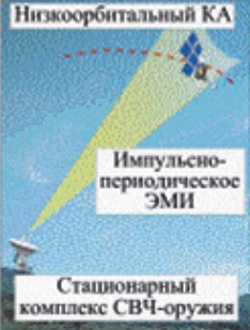 Russian drawing showing a ground-based microwave weapon attacking a satellite in low Earth orbit. (Source) |
There is seemingly also concern that Russia’s own satellites may fall victim to radio frequency weapons. ISS Reshetnev, the country’s leading manufacturer of communications and navigation satellites, has been co-operating with the Tomsk State University of Control Systems and Radio-Electronics (TUSUR) to develop special filters that would protect satellite power systems from electronic attacks with ultra-short pulse signals. The intention appears to be to install these on the newest Express communications satellites.[16]
Numizmat
Studying UWB signal propagation through the ionosphere also seems to be one of the objectives of a top-secret military space project called Numizmat (“coin collector”). It officially got underway on July 1, 2014, with a contract signed between the Ministry of Defense and the Central Scientific Research Institute of Chemistry and Mechanics (TsNIIKhM or CNIIHM), which has a background in developing anti-satellite technology.[17]
One of TsNIIKhM’s subcontractors for the project is the Sedakov Research Institute of Measurement Systems (NIIIS). Based in Nizhniy Novgorod, it became a branch of RFYaTs-VNIIEF in 2017. As can be determined from publicly available procurement documentation, NIIIS teamed up with a company named NPP Pulsar to develop so-called “radio frequency modules” for Numizmat to “amplify, detect and turn into digital form radio pulse signals on frequencies in the decimeter and centimeter wavebands.” The frequencies given in the available documentation range from 400 megahertz to 4 gigahertz and the signals have an average bandwidth of 25 megahertz.[18]
One joint NIIIS/NPP Pulsar article that is clearly related to Numizmat describes the payload as “a receiver of nanosecond pulse radio signals”, adding it can be used as “one of the receiving channels of a real-time ultra-wide band spectrum analyzer” (even though, strictly speaking, the bandwidth of the signals is not big enough to classify them as UWB signals.) The article elaborates only on the technical features of the receiver without describing its exact purpose or even relating it to a satellite project.[19]
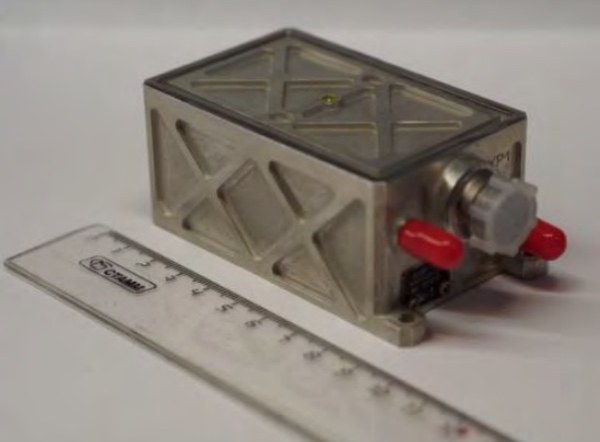 One of the compact UWB signal receivers built for Numizmat. (Source) |
The UWB spectrum analyzer in turn appears in a handful of NIIIS papers, two of which say it is needed to study the transmission of UWB signals through the atmosphere and ionosphere. It can be synchronized with a UWB signal generator by using “precise time signals,” a possible sign that the generator and/or receiver work in conjunction with the Glonass navigation satellites. The two articles appeared in 2013 and 2014, meaning that NIIIS began working on this payload even before receiving the Numizmat contract from TsNIIKhM in January 2015. They include a drawing of a satellite with a spectrum analyzer capable of receiving UWB signals in four different frequency ranges. It is not certain, though, if it this is what Numizmat eventually ended up looking like.[20]
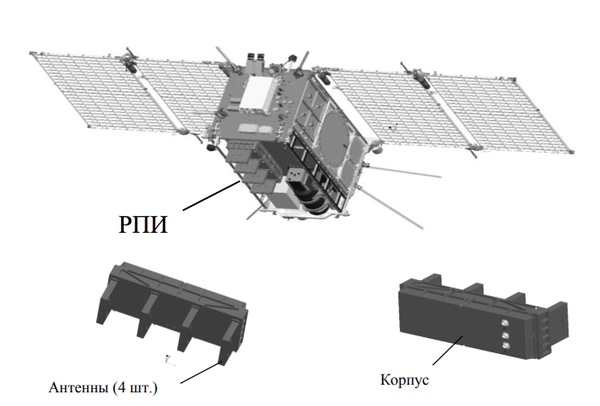 The four antennas of the UWB spectrum analyzer mounted on a satellite. (Source) |
All this does not answer the question what the ultimate purpose of Numizmat’s UWB payload is. Some NIIIS articles link research into UWB signal propagation through the ionosphere to space-based UWB radars.[21] One type in particular, a so-called UWB noise radar, is inherently immune from jamming, detection, and interference. This would make it well suited for covert rendezvous and proximity operations with other satellites (although any satellites attempting to sneak up on others could still quite easily be detected by ground-based optical or radar systems.) In this scenario, Numizmat would be likely to carry the generator itself and rendezvous with a target to reflect the signals.
Another possibility is that the Numizmat payload is somehow related to research on UWB anti-satellite weaponry. Pointing in that direction could be NIIIS’ ties with RFYaTs-VNIIEF as well as IPF, also located in Nizhniy Novgorod. It is worth noting that one of the papers on the UWB experiments at IPF’s Krot facility was co-authored by a NIIIS specialist who has been involved in research on the damaging effects of UWB electromagnetic pulses on satellite navigation equipment.[22] In this scenario, the generator would have to be installed on another satellite or on the ground. The fact that the UWB spectrum analyzer is designed to pick up signals transmitted both through the atmosphere and ionosphere would be indicative of the latter. One sign that UWB weapons can be made small enough to be installed aboard satellites and have a significant range comes from a Chinese paper published in 2023. This discusses the possibility of deploying a constellation of low-Earth orbit satellites with UWB transmitters to jam ground-based satellite navigation receivers.[23]
Whether Numizmat has already flown is not known. Considering the fact that the project was started ten years ago, it certainly could have done so by now. In the past three years or so, Russia has launched a number of military satellites that cannot be linked with certainty to any known projects. One particularly puzzling series of satellites was launched between September 2021 and March 2023 under the names Kosmos-2551, 2555, 2560, and 2568. Insiders writing on Russian space forums have identified them as EO MKA, which may stand for “prototype of a small satellite.” The first three did not carry out any maneuvers and re-entered after just weeks in orbit. The fourth began making regular orbit corrections after months of slow decay and is still in orbit more than a year after launch.
| There are no clear signs that the orbiting of nuclear weapons is part of Russia’s military doctrine or that any recent Russian military launches are directly related to such a weapon. However, any evidence for its existence would probably be so sensitive that it is very unlikely to be available in the public domain. |
Also defying explanation so far is a pair of satellites (Kosmos-2561 and 2562) launched together in October 2022. Kosmos-2562 spent several months performing rendezvous and proximity operations with Russia’s decommissioned Resurs-P3 remote sensing satellite before both re-entered. Kosmos-2561 is on a solo mission, but for several weeks was in an orbital plane very close to that of Kosmos-2568, although it was orbiting about 150 kilometers higher. Finally, two satellites (Kosmos-2574 and 2575) launched in December 2023 and February this year are orbiting in almost exactly the same orbital plane and have distant encounters with each other roughly every two weeks.
What all these satellites have in common is that they are in low polar orbits, yet their on-orbit behavior is not typical of reconnaissance satellites. Any of these satellites could potentially be part of the Numizmat project, receiving UWB signals transmitted from the ground or either emitted or reflected by a companion satellite. With the Sun now reaching the maximum of its 11-year activity cycle and causing many disturbances in the ionosphere (especially in polar regions), this would be an ideal time to study the propagation of UWB signals in the space environment in challenging conditions.
Conclusions
The White House’s claim that Russia is developing a space-based nuclear weapon cannot be corroborated through open sources of information. There are no clear signs that the orbiting of nuclear weapons is part of Russia’s military doctrine or that any recent Russian military launches are directly related to such a weapon. However, any evidence for its existence would probably be so sensitive that it is very unlikely to be available in the public domain. What can be determined from academic literature is that Russia is conducting research on high-altitude nuclear explosions and their effects on the space environment. This research is not limited to theoretical calculations and computer simulations but is also being done in the form of experiments in plasma chambers. Still, that is not necessarily indicative of any active work on a space-based nuclear weapon.
Analysis of academic literature also indicates that Russia is exploring the possibility of deploying non-nuclear anti-satellite plasma and electromagnetic pulse weapons that would have a less devastating impact than nuclear weapons. While studies of plasma weapons so far appear to be purely theoretical, work on electromagnetic pulse weapons, particularly in the ultra-wide band range, may have reached a stage where space-based experiments have been or will be performed in the near future.
References
- Articles published in 2004, 2019 (1, 2) and 2020; PhD dissertation published in 2023 (p. 86-127); Video of PhD defense (1:00:25-1:02:20).
- Article published in 2022 ; Video of PhD defense (1:02:20-1:02:40).
- Articles published in 2018 (1 and 2 (p. 20-22)), 2019 (p. 33-36), 2022 and 2023.
- Article published in 2022.
- Article published in 2023.
- Article published in 2022 (p. 19-20).
- T. Wilson, Threats to United States space capabilities, prepared for the Commission to Assess United States National Security Space Management and Organization ; D. Green, M. Silva, Military applications of high-power microwaves, Defence Research and Development Canada, 2023.
- D. Right et al, The physics of space security, American Academy of Arts & Sciences, 2005, p. 130-133.
- Article published in 2023, p. 58-61.
- Articles published in 2016, 2017, 2018 (p. 87-91) and 2020 (p. 214-219, 237-241).
- Articles published in 2019, 2021, 2023 and 2024 (all in English).
- Articles published in 2021, 2022 (1 and 2) and 2023.
- Program of a 2022 military conference in St.-Petersburg, p. 43.
- Article published in the South China Morning Post, March 30, 2023 (paywalled). Summarized here.
- Patent published in 2020 (in Russian and English).
- PhD dissertations published in 2018, 2019 and 2022.
- B. Hendrickx, Russia’s secret satellite builder, The Space Review, May 6, 2019.
- Tender documentation published in June 2016 ; Numizmat thread on the NASA Spaceflight Forum.
- Article published in 2019 (p. 126-132).
- Articles published in 2013 (p. 5-6) and 2014 (p. 68-70).
- Article published in 2016 (p.195-207).
- Article published in 2017.
- Article (with English summary) published in 2023.
Note: we are now moderating comments. There will be a delay in posting comments and no guarantee that all submitted comments will be posted.
